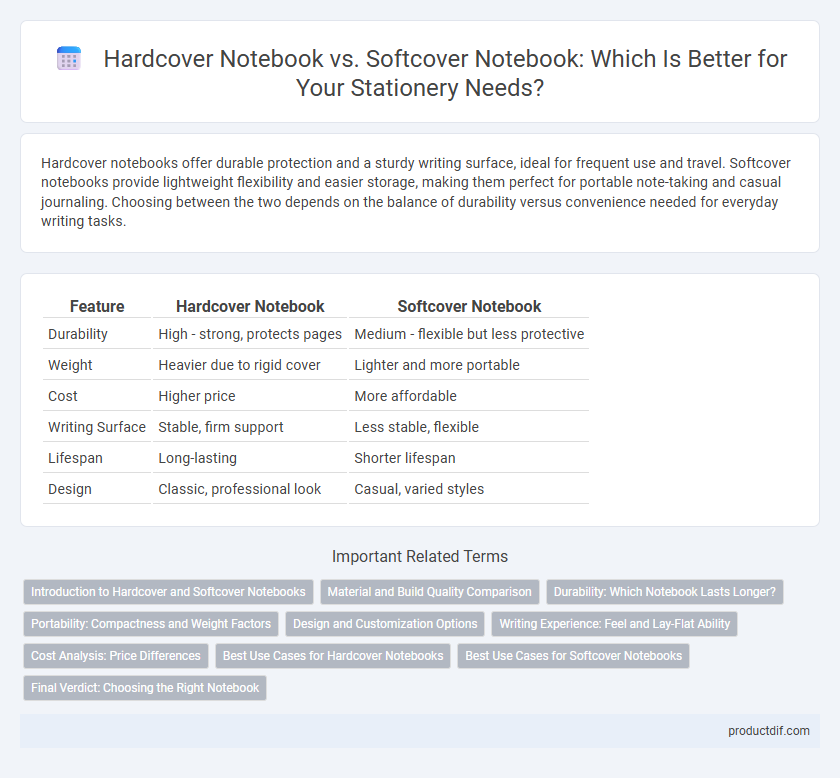Hardcover notebooks offer durable protection and a sturdy writing surface, ideal for frequent use and travel. Softcover notebooks provide lightweight flexibility and easier storage, making them perfect for portable note-taking and casual journaling. Choosing between the two depends on the balance of durability versus convenience needed for everyday writing tasks.
Table of Comparison
| Feature | Hardcover Notebook | Softcover Notebook |
|---|---|---|
| Durability | High - strong, protects pages | Medium - flexible but less protective |
| Weight | Heavier due to rigid cover | Lighter and more portable |
| Cost | Higher price | More affordable |
| Writing Surface | Stable, firm support | Less stable, flexible |
| Lifespan | Long-lasting | Shorter lifespan |
| Design | Classic, professional look | Casual, varied styles |
Introduction to Hardcover and Softcover Notebooks
Hardcover notebooks feature rigid covers made from thick cardboard or plastic, offering enhanced durability and protection for notes, making them ideal for long-term use and frequent handling. Softcover notebooks, with flexible and lightweight covers typically made from cardstock or coated paper, provide greater portability and ease of use for quick note-taking and casual writing. Both types cater to different user preferences, balancing protection and convenience based on the intended purpose.
Material and Build Quality Comparison
Hardcover notebooks feature a robust, rigid cover made from thick cardboard or pressed fiberboard, providing superior durability and protection for pages, ideal for frequent handling or travel. Softcover notebooks utilize flexible, lighter materials like cardstock or coated paper, offering greater portability but less resistance to wear and tear. The build quality of hardcover notebooks generally ensures longer lifespan and better page alignment, while softcovers prioritize convenience and lightweight design.
Durability: Which Notebook Lasts Longer?
Hardcover notebooks feature a rigid cover made from thick cardboard or synthetic materials, providing superior protection against wear, moisture, and impacts, making them ideal for long-term use. Softcover notebooks, often made with flexible paper or thin cardstock, are lightweight and portable but more prone to bending, tearing, and damage over time. Durability-wise, hardcover notebooks generally last longer, maintaining their structural integrity and safeguarding pages better than softcover options.
Portability: Compactness and Weight Factors
Hardcover notebooks offer robust protection but tend to be heavier and less compact, making them less ideal for highly portable usage. Softcover notebooks provide lightweight and flexible options, enhancing portability and ease of carrying in bags or pockets. Weight differences typically range from 100 to 300 grams, with softcovers consistently outperforming hardcovers in compactness and convenience for on-the-go note-taking.
Design and Customization Options
Hardcover notebooks offer a rigid, durable cover that protects pages and provides a premium feel, often allowing for embossing and foil stamping customization. Softcover notebooks feature flexible, lightweight covers that are easier to carry and frequently support full-color printing and wrap-around designs for personalized artwork. Both options cater to various aesthetic preferences and branding needs, with hardcover being ideal for professional use and softcover suited for creative, vibrant customization.
Writing Experience: Feel and Lay-Flat Ability
Hardcover notebooks offer a sturdy writing surface that enhances handwriting precision and durability, making them ideal for note-taking and sketching on the go. Softcover notebooks provide flexibility and lightweight convenience, but may lack the firm support needed for smooth writing without a hard backing. Lay-flat ability is typically superior in premium hardcover designs with sewn bindings, allowing a seamless writing experience, while softcovers often rely on spiral or stitched bindings to improve flatness.
Cost Analysis: Price Differences
Hardcover notebooks generally have higher production costs due to durable materials like thick cardboard and protective coatings, leading to price points 20-40% above softcover notebooks. Softcover notebooks, made with flexible cardstock or paper covers, offer a budget-friendly option with lower manufacturing expenses reflected in prices often 30-50% less than hardcover variants. Consumers seeking long-lasting durability often invest more upfront in hardcover notebooks, whereas cost-conscious buyers prefer softcover notebooks for everyday use and affordability.
Best Use Cases for Hardcover Notebooks
Hardcover notebooks provide superior durability and protection, making them ideal for frequent use, travel journaling, or archival purposes where pages need to stay intact over time. Their rigid covers support writing without a flat surface, perfect for on-the-go professionals, students, and artists who require a dependable writing surface. Hardcover notebooks also often feature sewn bindings, enhancing longevity and securely holding pages for extensive note-taking or project documentation.
Best Use Cases for Softcover Notebooks
Softcover notebooks excel in portability and flexibility, making them ideal for students and professionals who need lightweight, easy-to-carry options for daily note-taking or brainstorming sessions. Their pliable covers allow for comfortable writing on uneven surfaces, perfect for fieldwork or on-the-go creativity. Affordable pricing and variety in sizes further enhance their suitability for casual journaling, quick sketches, and temporary project planning.
Final Verdict: Choosing the Right Notebook
Hardcover notebooks offer superior durability and protection, making them ideal for frequent use or travel, while softcover notebooks provide greater flexibility and lightweight convenience suited for casual note-taking. Consider factors such as personal usage habits, portability needs, and aesthetic preferences when deciding between the two. Opt for a hardcover notebook for longevity and structured support, or select a softcover version for ease and adaptability in everyday writing tasks.
Hardcover Notebook vs Softcover Notebook Infographic

 productdif.com
productdif.com